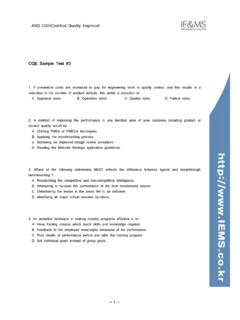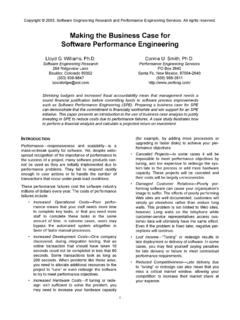Transcription of Ch.2 Logistics System Engineering. - IEMS
1 Part 1 : System Management. Logistics System by Dr. Seung Hyun Lee ( , CPL)IEMS Research Center, E-mail : 1 -Definition of System . [Blanchard, System engineering ]Definition of System An aggregation or assemblage of objects united by some form of regular interaction or interdependence : A group of diverse units combined by nature or art as to form an integral whole, and to function, operate, or move in unison and, often, in obedience to some form of control ; an organic, or organized whole. - 2 -Definition of System . [Blanchard, System engineering ]Characteristics of System . 1. A System constitutes a complex combination of resources in the form of human being, materials, equipment, software, facilities, data, money, and so on.
2 2. A System is contained within some form of hierarchy. 3. A System may be broken down into subsystems and related components, the extent of which depends on complexity and the function(s) being performed. 4. The System must have a purpose. It must be functional, be able to respond to some identified need, and it should be able to achieve its overall objective in a cost effective manner. - 3 -Definition of System . [Blanchard, System engineering ]Different Systems. Natural and man-made System . Physical and conceptual systems. Physical systems are those made up of real components occupying space. On the other hand, conceptual systems constitute an organization of ideas, a set of specifications and plans a series of abstract concepts, and so on.
3 Static and dynamic systems. Static systems include those having structure, but without activity as viewed in a relatively short period time. A dynamic System is one that combines structural with activity. Closed and open-loop systems. A closed System is one that is relatively self-contained and does not significantly interact with its environment. Conversely, open-loop systems interact with their environment. - 4 -Definition of System . [Other Materials]Endogenous vs. Exogenous Variables. Endogenous Variables. - A variable whose value is determined by relationships included within the System .
4 - The term endogenous is used to describe activities and events occurring within a System . Exogenous Variables. - A variable whose values are determined by considerations outside the System . - The term exogenous is used to describe activities and events in the environment that affect the System . - 5 - System engineering . [Blanchard, System engineering ]Definition and Objectives of System engineering . Definition. The effective application of scientific and engineering needing efforts to transform an operational need into a defined System configuration through the top-down iterative process of requirements analysis, functional analysis, allocation, synthesis, design optimization, test and evaluation.
5 Objectives of System engineering . 1. Transformation of an operational need into an integrated System design solution through concurrent consideration of all life-cycle needs. 2. Ensure the compatibility, interoperability, and integration of all functions and physical interfaces and ensure that System definition and design reflect the requirements of all System elements. 3. Characterize and manage technical risks. - 6 - System engineering . [Blanchard, System engineering ]Characteristics of System engineering . Top-down Approach. A top-down approach is required, viewing the System as a whole. While engineering activities in the past have very adequately covered the design of various System components, the necessary overview and an understanding of how these components effectively fit together have not always been present.
6 Life-cycle Orientation. A life-cycle orientation is required. Addressing all phases to include System design, and development, production, and/or construction, distribution, operation, sustaining support, and retirement and phase out. - 7 - System engineering . [Blanchard, System engineering ]Characteristics of System engineering . Focus on the initial identification of System requirements. A better and more complete effort is required relative to the initial identification of System requirements. Relating these requirements to specific design goals, the development of appropriate design criteria, and the follow-on analysis effort to ensure the effectiveness of early decisions in the design process.
7 Interdisciplinary or Cross-functional Approach. An interdisciplinary effort (or team approach) is required throughout the System design and development to ensure that all design objectives are met in an effective manner. This necessitates a complete understanding of the many different design disciplines and their interrelationships, particularly for large projects. - 8 -Activities in System engineering . [Blanchard, System engineering ] Benjamin S. Blanchard, " Logistics engineering and Management," 6th ed, Prentice-Hall, 2004. 9 - Logistics System engineering . [Blanchard, System engineering ] Logistics System Life Cycle Phase. Benjamin S. Blanchard, " Logistics engineering and Management," 6th ed, Prentice-Hall, 2004.
8 10 - Logistics System Life Cycle Phase. [Blanchard, System engineering ] Customer Need Identification. Needs may stem from several sources, representing a current or anticipated deficiency. The need or mission objective should be described in detail and a time frame for its development established. Outputs of need identification : - User needs are identified. - Nature of System is defined. - Time table for System development established, including project management. - 11 - Logistics System Life Cycle Phase. [Blanchard, System engineering ] Conceptual Design. Conceptual design constitutes the first step in the overall design process and is initiated in response to an identified customer need.
9 - Feasibility studies are accomplished. - System operational requirements and the maintenance concept are defined. - A top-level functional analysis for the System may be completed, the System specification is prepared to describe the design requirements for the System . - 12 - Logistics System Life Cycle Phase. [Blanchard, System engineering ] Preliminary Design. - Identification of alternative System operational functions and sub-functions and maintenance functions. - The allocation of requirements from the top-level System to the various subsystems in terms of performance and effectiveness requirements and System supportability.
10 - System optimization through evaluation of System alternatives involving reviewing the trade-offs within each System as compared with other systems. - System synthesis and definition involving putting together the proposed System in analytical form or in a physical model based on detailed specifications. - 13 - Logistics System Life Cycle Phase. [Blanchard, System engineering ] Detail Design and Development. It is referred to as full-scale development. It involves : - Detailed descriptions of subsystems and elements, etc,, comprising the prime mission equipment and the elements of the Logistics support System , - Development of an engineering model or prototype that will allow testing and verification of design adequacy.











